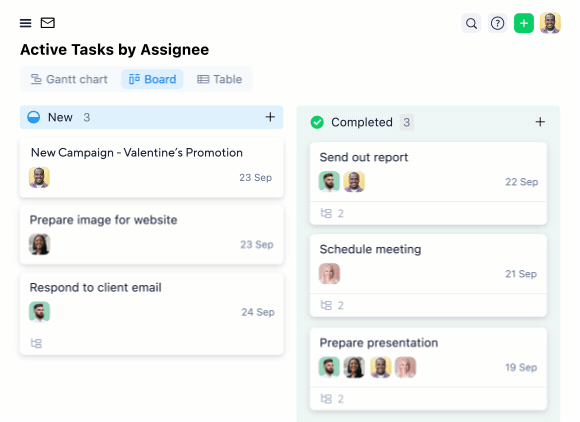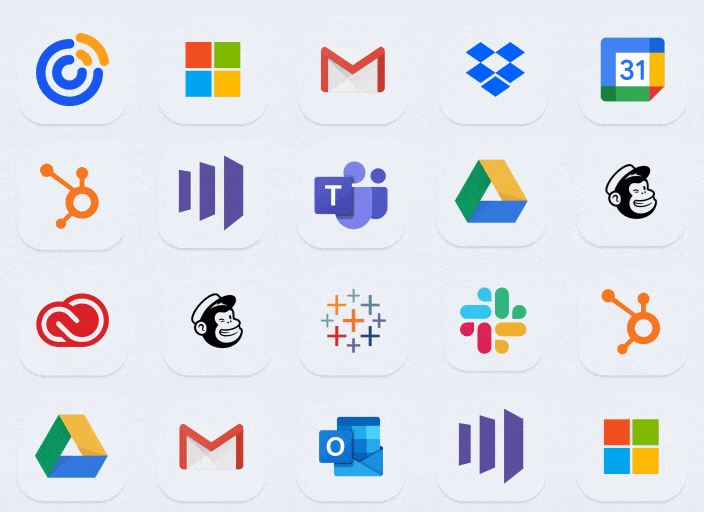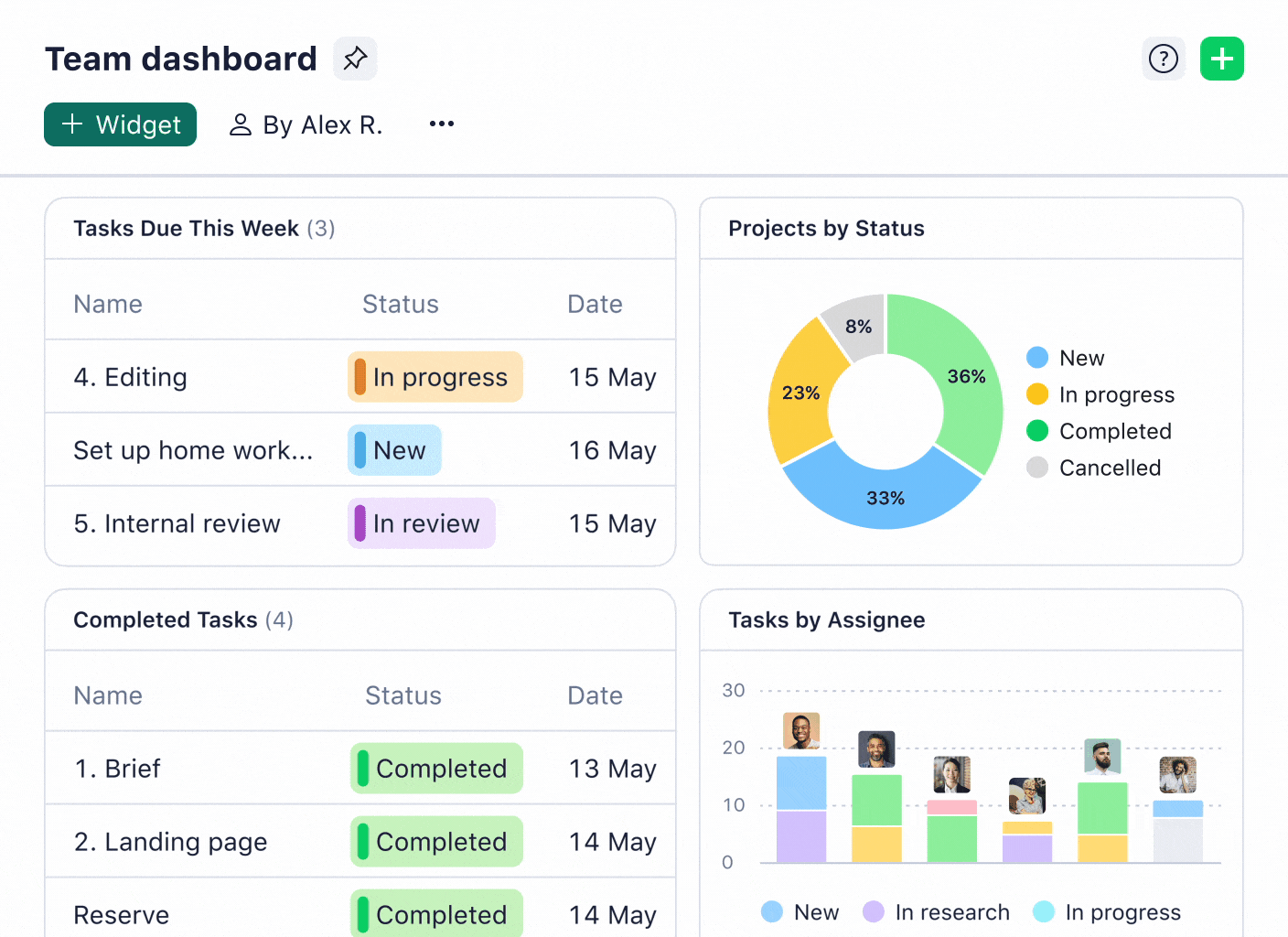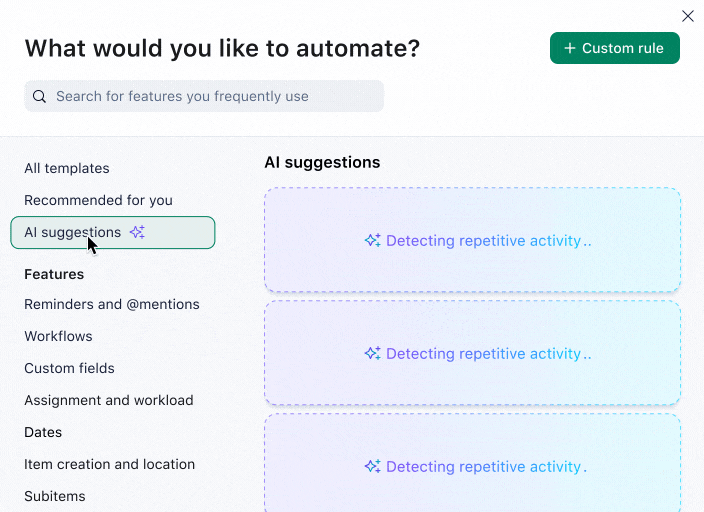Organizations typically turn to professional services automation (PSA) software when they need support with administrative processes such as resource or project management, time tracking, and financial planning.
Naturally, one of the key elements of this software is automation. The best PSA software should literally take some of the work of professional services out of your hands by automating manual tasks and workflows that are performed repeatedly.
But weirdly enough, most conventional PSA software doesn’t actually do a lot of automation. Instead, it simply provides a system for you to manage your projects, resources, finances, and services yourself.
In this guide, we want to show you why that’s not enough. We’ll explain why only the PSA tools that really put automation first are worth your time. Then, we’ll share how our work management software, Wrike, makes your professional services business much more efficient.
The real automation that should be the core of your PSA software
Despite the name, one of the surprising things about a lot of professional services automation software is that automation is not its forte. These tools may feature some automated notifications and alerts. But, in reality, that won’t go very far in helping you manage your work.
To get real productivity gains in professional services businesses, you’ll benefit from smarter and more robust automations that literally do your work for you.
So, when comparing PSA software, look for:
- Automation that reduces repetitive, manual work. In professional services, there’s a lot of admin, often involving data entry, repetitive processes, and manual tasks. Effective automation lifts the burden of this busywork. For instance, with a powerful automation tool, you can share updates or request feedback across channels, automate invoice creation, or even distribute work to the colleagues that are best suited to specific tasks.
- Automation that keeps you all on the same page. Automated notifications about completed tasks or status updates are useful. But automation can do so much more in terms of sharing information across your teams. For example, using an automatically updated system, all your colleagues can access real-time insights into what’s happening across your professional services department, agency, or organization — right down to the specific tasks people are working on right now.
- Automation that reduces error and ensures high-quality work every single time. When you’re working with sensitive legal, commercial, or other professional information, the consequences of an error or delay can be significant. Rule-based automations can standardize internal processes, ensure deadlines aren’t missed, and identify any tasks or projects that are at risk of disruption.
- Automation that extracts critical insights from the way you and your teams work. To improve the productivity and efficiency of your professional services agency, data on how you’re currently performing is critical. The right automation tools can serve this information at the click of a button — and then generate reports that are useful for the whole organization.
If you’re a professional services organization that wants to perform better, effective automation is critical. That’s why Wrike has built some of the most advanced automations into our PSA software.
In the rest of this article, we’ll show you how our platform works for professional services — and how you too can benefit from its automation features.
How Wrike automates your professional services workflows
At Wrike, our work management software is used by over 20,000 organizations worldwide, including professional services teams such as lawyers, marketing departments, and accounting firms.
To help organizations and teams drive efficiency and deliver better work, we’ve put automation at the center of what our software does. And the results speak for themselves. For instance, we’ve helped the creative team at Sony Pictures Television reduce the amount of time they spend on projects by 40%.
Here’s how you can benefit too.
1. Let Wrike complete your tasks for you, thanks to workflow automation rules
If your PSA platform’s automations are limited to notifying you about the status of work, you’ll be missing out on critical opportunities for efficiency. Today, workflow automation software can do a lot more, from gathering data to creating documents from scratch.
Standardize work requests and automatically allocate tasks with dynamic intake forms
Whether you’re a marketing team or a lawyer’s office, you’ll likely receive requests for work every day. The trouble is that these can come in a variety of forms, and through a variety of channels.
With Wrike’s custom request forms, you can standardize these requests and automate the allocation of work completely. Simply create a form with the information you need, and our automation engine can set up the required steps in the workflow, define deadlines, and allocate tasks, from ideation to approval.

Choose from common automation use cases, to quickly see efficiency gains
At Wrike, we know firsthand the kinds of tasks and processes that professional services teams need to automate. And with our library of automation use cases, it’s easy to get started with making time savings.
Our automations follow a rule-based logic with a when/then structure. For example, when a task is completed, then an @mention is sent. Our library features hundreds of these productivity boosters that are ready to be deployed. If you don’t find the automation you’re looking for, you can easily set up your own.

Set up task automations across your integrations, for faster processes
While we’re confident that Wrike can provide a lot of the workplace support you need, you’ll likely be using other tools as well. That’s why we’ve built our automations to work across more than 400 native integrations, including Slack, Adobe Creative Cloud, HubSpot, and much more.
So, for example, once you’ve completed a project, you can automatically create an invoice in QuickBooks. Or when the status of a task changes, you can set up a new event in Google Calendar.
2. Stay aligned with real-time visibility on your collaborative work
One of the most significant challenges for professional services teams, particularly in large organizations, is simply knowing what your colleagues are working on — and how they’re performing.
While many basic project management or PSA tools will give you some visibility on the status of shared tasks, Wrike gives you the real clarity your teams need to deliver collaborative work on time and on budget.
Get total clarity on all collaborative work with automatically updated workflow visualizations
Whether you prefer the simplicity of Kanban boards, the dynamism of Gantt charts, or the intuitiveness of a calendar view, with Wrike you can visualize your work the way that works best for you. But whatever each team member chooses, they’ll see a live view of your projects, with real-time statuses, predicted deadlines, and project risk — all based on the most recent data.
Customize dashboards for real-time project data
As well as having a view on your shared work, every colleague can set up their own dashboard in Wrike that can be customized to their specific needs. They may need a quick view of financial data, a live stream of tasks to be done, or all relevant resources in one place. Whatever their requirements, their dashboard is updated automatically, so no one needs to waste time sharing statuses or resources.

Use custom item types to get extra visibility on your work (and automate them too)
Too often, professional services teams have to wrestle with software that doesn’t fit their needs. This forces them into a different way of working. That’s why we developed custom item types, namely unique items in your software that aren’t limited to the conventional hierarchy of projects and tasks.
These can be used for any purpose you choose, whether that’s meeting minutes, project files, software bugs, or something else entirely. Then, these can be automated via the automation rules we shared above.
inDrive, a California-based urban mobility company, wanted a tool to replace disorganized email-based workflows and boost productivity overall. It chose Wrike and has never looked back — and that’s in large part thanks to the greater visibility our platform offered.
For instance, by using custom item types, inDrive has been able to index key information about different projects. And as a result, it has managed to cut out repeat tasks and reduce time to production by as much as 25%.
3. Use Wrike AI to identify new automation opportunities and track project risk
AI has the potential to transform the professional services industry. And one way that it can be deployed is in your work management processes, to speed up tasks and help you work more intelligently.
At Wrike, we’ve enhanced our professional services automation software with Work Intelligence®. This technology can help with content creation and editing and will boost your efficiency by summarizing documents, comments, or content too.
But it does much more — by streamlining workflows, aiding project planning, and ensuring every task has all the resources it needs.
Let AI identify new opportunities for automation, based on your work patterns
Sometimes, you just won’t be aware that the tasks you often perform can be automated at all. Wrike’s AI solves this problem. By tracking your workflows, Wrike can identify the tasks you regularly perform which could be optimized. Then, it automatically suggests these for automation.

Identify projects that are most at risk of disruption with AI
By automatically tracking historical project data and then analyzing it using machine learning, Wrike Intelligence can help you spot the projects that are most at risk — before they fail or go over budget. It can help you ensure that every task has the resources that it needs.
3 professional services companies using Wrike for more efficient processes
So far, you’ve seen what Wrike can do. But how are real companies using our PSA tool already?
Here are three examples of professional services organizations that are using our tool to save time, boost productivity, and deliver better results for their clients.
1. Granicus uses Wrike to reduce paper processes and improve flexibility for teams
Granicus is a software company that helps governments transform their user experience by modernizing their online services, digital communications, public meetings, and records management. But before the professional services team approached Wrike, it was struggling with as many as eight different project management tools to manage its work.
“We have lots of teams that work together on bigger professional services projects,” explains Cassidy Pillow, Senior Manager of Client Services Operations at Granicus. “We needed to find one single solution to help us be more successful.”
Granicus switched out those various tools — as well as the paper processes it was still using — for Wrike’s PSA system.

One of the main reasons we selected Wrike was because it was so intuitive. It just makes sense. The integrations, APIs, automated workflows and processes — that’s what really sealed the deal for us with Wrike. It fits right into our existing tech stack.
Cassidy Pillow, Senior Manager of Client Services Operations
Now, Granicus is managing 200 new projects in Wrike every month and has served 1,200 external clients through our software.
What makes Wrike ideal for professional services?
“Definitely the flexibility to serve different professional services units for different products,” says Cassidy. “I talked a lot about our ability to make more processes uniform. But there’s also enough flexibility [in Wrike] that we were able to give teams the keys to certain parts of their kingdom.”
Read the full story: From Many to One: Granicus’s Shift to a Single Work Management Platform With Wrike
2. How Aerotek reduces the number of emails by 90% with Wrike
Aerotek is the largest staffing and recruiting company in the US, serving over 300,000 contract employees and 18,000 clients each year. When Matt Andrews joined the marketing team to lead campaigns, he wanted to build a new, more collaborative structure that streamlined the way projects were managed.
“We saw a lot of process, email, and phone calls and wanted to avoid booking excessive amounts of meetings or losing important things in emails,” Matt says. “Some projects that only lasted four or five weeks had hundreds of emails, which is excessive. We knew we had to find a way to streamline this.”
Andrews and his team turned to Wrike. Since then, they’ve seen an 85-90% reduction in the number of internal emails they send.
One of the most useful features of Wrike for Aerotek is dynamic request forms. With requests for content coming through constantly, teams were feeling overwhelmed, particularly as these requests didn’t have a standard form or process.

Rather than get a phone call or an email resulting in a longer phone call or a meeting, they now go to Wrike and fill out a very robust request form.
Matt Andrews, Marketing Campaign Manager
“When a request comes through, it triggers the creation of a job that your team is going to work on from start to finish, and once it’s done, we can archive it and it’ll be there forever.”
3. How Kalexius uses Wrike to save 20% of time on legal services
Kalexius is a Geneva-based legal services provider focusing on financial services, regulatory, contracts, and corporate work.
“We generally don’t undertake small projects,” says Stella Peterson, Head of Legal Operations at Kalexius. “Our projects are typically over 1,000 contracts. When you’re working at that volume and with a specific deadline, you have to make sure that you’re optimizing everything and you’re hyper-efficient.”
And Wrike helps Kalexius achieve that.
“[In Wrike,] we have a record and visibility of everything that’s being done, and we can make sure that we’re utilizing all our resources at 100%,” says Peterson.
“In terms of time savings, Wrike saves us about 20% because we don’t need to look for documents or information.
Every week I create reports for clients, and every week I can do that faster because we automate everything. It’s a huge time saver. Because the data is readily available in Wrike, we can pull reports in just five minutes.
Stella Peterson, Head of Legal Operations
Find out more: Kalexius Uses Wrike to Deliver Legal Services Efficiently, From Anywhere
Streamline your professional services with Wrike’s PSA software
If your professional services team is serious about improving your efficiency, delivering better work, and improving your client experience, you need to get serious about automation. Wrike’s PSA software helps you do exactly that.
Book a demo to find out how it can work for you.






